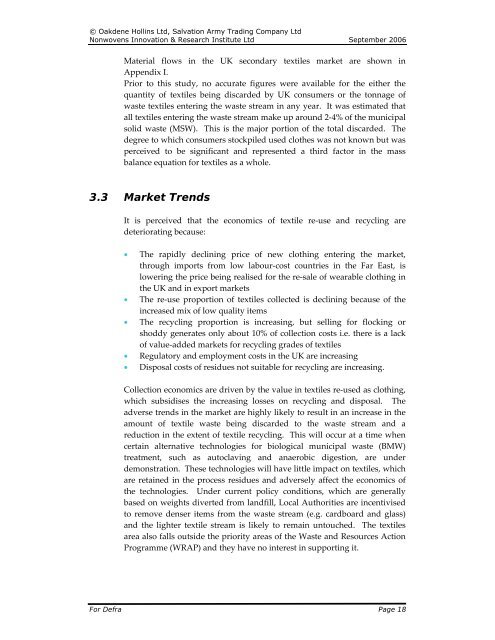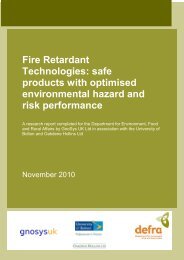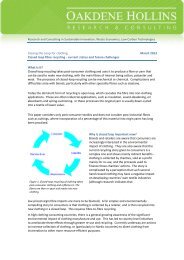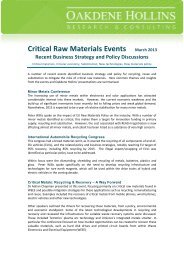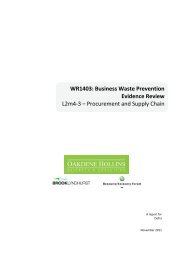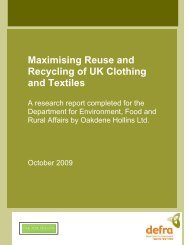Recycling of Low Grade Clothing Waste - Oakdene Hollins
Recycling of Low Grade Clothing Waste - Oakdene Hollins
Recycling of Low Grade Clothing Waste - Oakdene Hollins
You also want an ePaper? Increase the reach of your titles
YUMPU automatically turns print PDFs into web optimized ePapers that Google loves.
© <strong>Oakdene</strong> <strong>Hollins</strong> Ltd, Salvation Army Trading Company Ltd<br />
Nonwovens Innovation & Research Institute Ltd September 2006<br />
Material flows in the UK secondary textiles market are shown in<br />
Appendix I.<br />
Prior to this study, no accurate figures were available for the either the<br />
quantity <strong>of</strong> textiles being discarded by UK consumers or the tonnage <strong>of</strong><br />
waste textiles entering the waste stream in any year. It was estimated that<br />
all textiles entering the waste stream make up around 2‐4% <strong>of</strong> the municipal<br />
solid waste (MSW). This is the major portion <strong>of</strong> the total discarded. The<br />
degree to which consumers stockpiled used clothes was not known but was<br />
perceived to be significant and represented a third factor in the mass<br />
balance equation for textiles as a whole.<br />
3.3 Market Trends<br />
It is perceived that the economics <strong>of</strong> textile re‐use and recycling are<br />
deteriorating because:<br />
• The rapidly declining price <strong>of</strong> new clothing entering the market,<br />
through imports from low labour‐cost countries in the Far East, is<br />
lowering the price being realised for the re‐sale <strong>of</strong> wearable clothing in<br />
the UK and in export markets<br />
• The re‐use proportion <strong>of</strong> textiles collected is declining because <strong>of</strong> the<br />
increased mix <strong>of</strong> low quality items<br />
• The recycling proportion is increasing, but selling for flocking or<br />
shoddy generates only about 10% <strong>of</strong> collection costs i.e. there is a lack<br />
<strong>of</strong> value‐added markets for recycling grades <strong>of</strong> textiles<br />
• Regulatory and employment costs in the UK are increasing<br />
• Disposal costs <strong>of</strong> residues not suitable for recycling are increasing.<br />
Collection economics are driven by the value in textiles re‐used as clothing,<br />
which subsidises the increasing losses on recycling and disposal. The<br />
adverse trends in the market are highly likely to result in an increase in the<br />
amount <strong>of</strong> textile waste being discarded to the waste stream and a<br />
reduction in the extent <strong>of</strong> textile recycling. This will occur at a time when<br />
certain alternative technologies for biological municipal waste (BMW)<br />
treatment, such as autoclaving and anaerobic digestion, are under<br />
demonstration. These technologies will have little impact on textiles, which<br />
are retained in the process residues and adversely affect the economics <strong>of</strong><br />
the technologies. Under current policy conditions, which are generally<br />
based on weights diverted from landfill, Local Authorities are incentivised<br />
to remove denser items from the waste stream (e.g. cardboard and glass)<br />
and the lighter textile stream is likely to remain untouched. The textiles<br />
area also falls outside the priority areas <strong>of</strong> the <strong>Waste</strong> and Resources Action<br />
Programme (WRAP) and they have no interest in supporting it.<br />
For Defra Page 18


